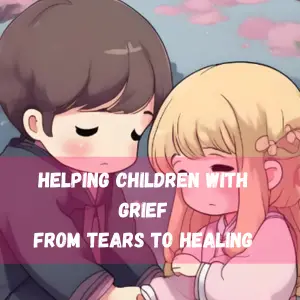Grief is a natural and universal human experience, yet navigating it can be incredibly challenging for children. Whether they’re coping with losing a loved one, a pet, or a significant life change, children struggle to express their emotions during this difficult time.
In this blog post, we’ll explore the importance of helping children with grief and providing practical strategies for assisting them to navigate this complex journey with compassion.
As an Associate of Amazon this post contains affiliate links. This means I may receive compensation if you should click and purchase something through them. This is at no extra cost to you.
Table of Contents
Understanding Children’s Grief
Children experience grief in unique ways that are influenced by their developmental stage, temperament, and previous experiences with loss. Unlike adults, who may express grief through tears and verbal processing, children often communicate their emotions through behavior, play, and physical symptoms.
Common reactions to grief in children may include sadness, anger, confusion, withdrawal, changes in appetite or sleep patterns, and regressive behaviors such as bedwetting or clinging to caregivers.
The Importance of Validation
One of the most crucial ways to support children with grief is to validate their emotions and provide a safe space for expression. Encourage open communication. You can do this by actively listening to their thoughts and feelings without judgment or criticism.
Acknowledge that feeling sad, angry, or scared is okay, and reassure them that their emotions are normal and valid. By validating their experiences, you help children feel seen, heard, and supported during this challenging time.
Honesty and Openness
When discussing grief with children, it’s essential to be honest and age-appropriate in your explanations. Avoid using euphemisms or vague language that may confuse or mislead them. Instead, provide simple, concrete explanations that align with their level of understanding.
Use clear and direct language to explain the concept of death or loss, and be prepared to answer any questions they may have truthfully. While it’s natural to want to shield children from pain, honesty fosters trust. It helps children develop a healthy grasp of loss.
Encouraging Expression Through Play and Art
Children often process their emotions through play and creative expression. Encourage them to explore their feelings through drawing, painting, storytelling, or playing with dolls or action figures.
Provide art supplies and opportunities for imaginative play, allowing them to express themselves in comfortable and natural ways. Engaging in creative activities can help children externalize their emotions, gain control, and find comfort in self-expression.
Maintaining Routine and Stability
In times of grief, children crave stability and predictability to feel safe and secure. Maintaining familiar routines and rituals can provide comfort and normalcy during the chaos of loss.
Stick to regular mealtimes, bedtime routines, and daily activities as much as possible, even if other aspects of life feel uncertain. Create new rituals or traditions to honor the memory of the person or pet they’ve lost, such as planting a tree, making a memory book, or sharing stories and photos.
Encouraging Connection and Support
Loneliness and isolation can worsen children’s feelings of grief, so it’s essential to provide opportunities for connection and support. Encourage children to share their feelings with trusted friends, family members, or counselors who can offer empathy and understanding.
Consider enrolling them in grief support groups or therapy programs specifically designed for children, where they can connect with children who are experiencing similar circumstances. Providing a supportive network of caring adults and peers can help children feel less alone and more understood as they navigate their grief journey.
Modeling Healthy Coping Strategies
As caregivers, you play a crucial role in modeling healthy coping strategies for children. Be mindful of how you manage your grief and stress in front of them, demonstrating healthy ways of expressing emotions and seeking support.
Practice self-care and prioritize your well-being, as children often take cues from adults. Show them that it’s okay to ask for help when needed and that healing is a gradual process that takes time and patience.
Encouraging Hope and Resilience
While grief may feel overwhelming, reassuring children that brighter days lie ahead is essential. Encourage hope by focusing on positive memories and moments of joy, emphasizing the importance of resilience in the face of difficult times.
Remind children that it’s normal to experience ups and downs on the grief journey and that healing is possible with time, support, and self-care. Please encourage them to find meaning and purpose in their experiences.
While grief stays with us, we can learn to navigate it and accept it in a way that allows our life to continue with as much normalcy as possible.
Remembering Those Who Have Passed Away
Remembering someone who has passed away is a very personal and meaningful way to honor their memory. It allows us to keep their spirit alive in our hearts and minds, preserving the legacy they left behind. There are countless ways to remember a loved one, each offering comfort and solace in its unique way.
One of the most common ways to remember someone is through storytelling. Sharing anecdotes, memories, and experiences about the person allows us to relive special moments and celebrate their life.
Creating a memorial tribute is another powerful way to remember someone who has passed. This can take many forms, from planting a tree in their honor to dedicating a bench or plaque to a meaningful location. Memorials serve as tangible reminders of the person’s impact on our lives and provide a place for reflection and remembrance for years to come.
For artistically inclined people, creating artwork or crafts in memory of a loved one can be a therapeutic way to channel grief and express emotions. This could involve painting a portrait, composing a song, or crafting jewelry inspired by the person’s memory. Artistic expression allows us to channel our feelings into something tangible and beautiful, serving as a lasting tribute to the person we have lost.
Creating a scrapbook is a tangible way to preserve cherished mementos and keepsakes associated with the deceased person. This could include photos, letters, cards, or other items that hold special meaning. Looking through the memory box or scrapbook can evoke fond memories and provide comfort during grief.
Helping Children With Grief
As we help children cope with grief, we become their source of support, empathy, and comfort. By creating a space where they can express their feelings, hold onto memories, and heal, we give them essential tools to navigate their journey through loss.
Though it won’t be easy, our steady presence and caring guidance can guide them through the tough times. Together, we can build strength, honor the past, and look ahead with hope, knowing that love is stronger than any pain.
If you are interested in additional assistance in helping children with grief, there are many good books on the subject, as well as books tailored to children that could help them through their grieving process as well.


